Samsung Galaxy Tab Pro 8.4 and 10.1 Review
by Jarred Walton on March 22, 2014 9:30 PM ESTBattery Life
For battery life testing, we run the displays at 200 nits and test Internet surfing and H.264 720p video playback. In some cases the tablet OEMs have features built into the software that lock display brightness to a low (minimum) setting when battery life is less than 10%. The Galaxy Pro offerings appear to do this, though you can override the behavior in the power options. In real-world use, you can expect perhaps slightly better Internet battery life (as it's unlikely you'll be refreshing pages every 20 seconds) while the video playback results are exactly what you would do if watching a movie.
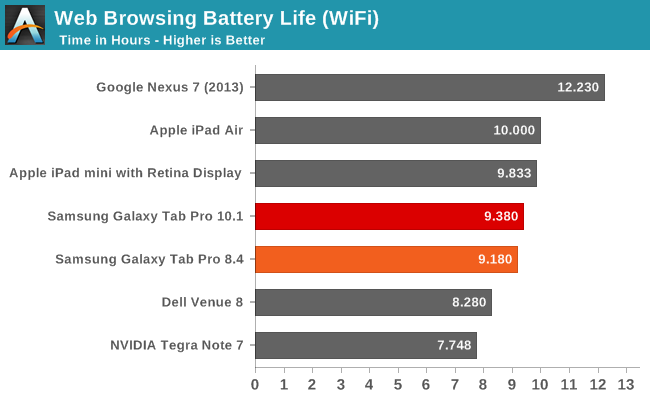
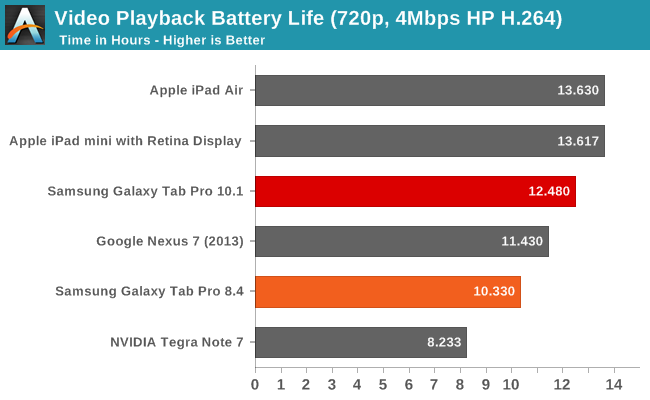
The Nexus 7 wins the WiFi testing result while the iPad Air and Mini Retina take the top two spots for the video playback (and silver and bronze in the Internet testing). It’s interesting that the two Galaxy Pro tablets are so close on the Internet results but the 10.1 does substantially better on the video playback. Either way, both tablets are at least capable of reaching their “up to 9/10 hours” advertised battery life, with perhaps a bit more if you’re willing to turn down the display brightness or shut off WiFi.
There are better tablets if you want as much battery life as possible, but given the ready availability of portable chargers and such I'm not sure it's all that critical. Gaming battery life is lower than the above results, of course, so plan on more like four to six hours of gaming (depending on the game) before needing to plug in.
Storage Performance
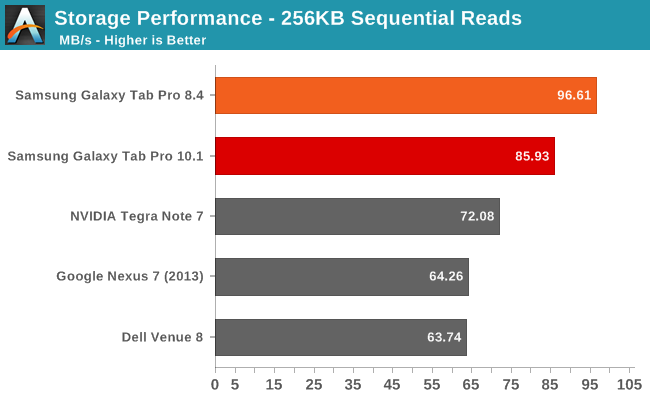
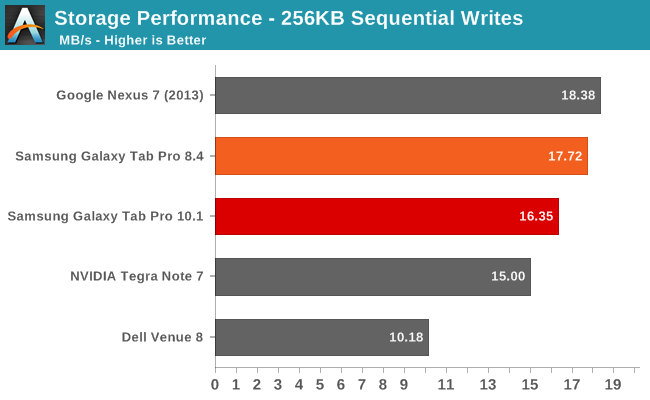
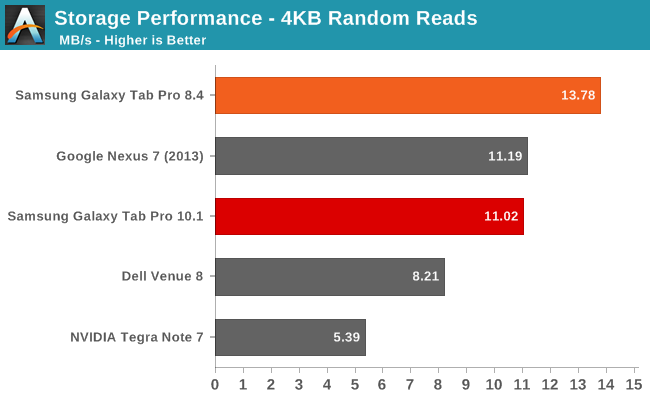
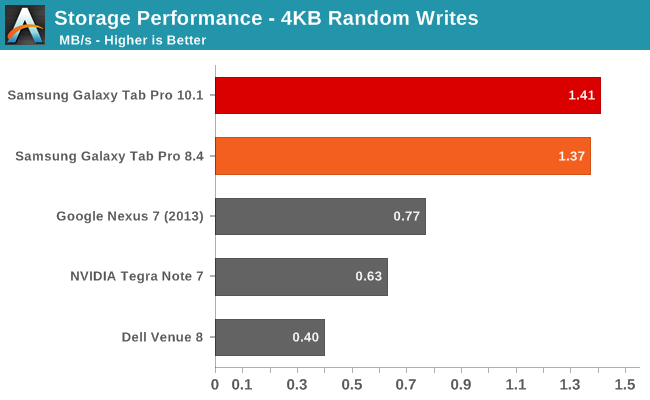
Having used several older Android tablets, the drop in storage performance over time can be extremely painful. With Android 4.3 and 4.4 now supporting TRIM, hopefully things will stay running a bit more smoothly over a long period of time. As it stands, we don’t have all that many results for our Android storage benchmarks (and no cross-platform test for iOS yet), but the Samsung eMMC looks to be better than most of what we’ve tested. The random write speeds in particular are nearly twice as fast as that of the Nexus 7, and we’re at least consistently beating typical hard drive performance with >1MBps random I/O. Hopefully we’ll see even faster NAND/controller solutions upcoming tablets.










125 Comments
View All Comments
TestKing123 - Tuesday, March 25, 2014 - link
It's true the Yogo 2 Pro is in an entirely different segment/market than an Ipad or Android tablet, but I found I'm using this device far more often than any of my other tablets. The screen is 13.3 but a beautiful QHD display (higher than Retina), very responsive and incredibly fast. The major apps are all on Windows 8 anyways, though I don't care for the App store that much. I can use it as a tablet or PC with a flip of the backside, and I can run all my business software AND play some decent PC games as well.It literally made by tablet collection (and I love buying the newest tablets) obsolete.
johnny_boy - Sunday, March 23, 2014 - link
I think the lg g pad 8.3 makes a good lower cost competitor to the tab pro 8.4. It's sporting previous gen snapdragon soc but 2gb ram and basically the same dimensions and weight. I personally don't think the extra cost of the tab is worth it over the g pad.RobilarOCN - Monday, March 24, 2014 - link
Have you owned a G Pad? I recently sold mine and switched to the Tab Pro 8.4. You might want to have a look at the XDA forum section for it. Despite an amazing aluminum body, the screen on the G Pad is terrible. I paid $350 for it (got it before LG heavily discounted it and then released the google play edition). It is hands down the dimmest tablet screen I have ever used. I was lucky enough not to get one of the "crappy" ones (of which there are apparently many), I didn't have the blue line of doom on the screen or excessive light bleed around the edges (Both of which are very common). Still, even at 100% brightness, it is dimmer than a Nexus 7 or a tab pro at 50%. Impossible to use in sunlight (I took it on vacation). Also the battery life was not good. There is a reason that LG dropped the tablet price by $100 within a month of it's release. Too bad because it has a lot of other amazing things going for it. The screen is the deal breaker though. So yes, the extra cost makes it a big difference... Plus LG is discontinuing the $250 version in favor of the $350 google play edition. A $50 difference for a vastly better screen, faster SOC and better battery? Abolutelywintermute000 - Monday, March 24, 2014 - link
if u can't ROM away the custom magazine UI then no sale. Haven't kept up but aren't Sammy devices getting harder and harder to mod?Woody - Sunday, March 23, 2014 - link
Haha!! what age do you consider "getting old"This is exactly what I'm thinking when I look at screen size these days....thinking about switching from my Galaxy S series for a Galaxy Note for this very reason.
Or I could just get reading glasses. ughh!
frozentundra123456 - Sunday, March 23, 2014 - link
Nice, but more than I would pay for any android device.martixy - Monday, March 24, 2014 - link
That moment when you skim the specs and notice that the display size is always bigger than the stated physical dimensions of the device.It takes a second...
skrewler2 - Friday, March 28, 2014 - link
You mentioned the Note 2014 having the same specs on the first page, but didn't include these in any of the benchmarks to confirm they are indeed the same tablet with just the inclusion of the S-Pen?Also, you didn't include a comparison between the Note / Note pro / Galaxy / Galaxy pro in your closing thoughts.
I got my Galaxy Note 10.1 2014 edition on special for $400 back in Jan (also w/ a bunch of goodies.. Google store credit, Samsung store credit, Dropbox, evernote pro, a bunch of other stuff). I was kinda bummed that shortly after I purchased it that the Note Pros came out, but other than 10" vs 12" it's hard to tell what exactly is different between them. I remember coming to the conclusion that the Pro model adds some features for businesses / BYOD, notably for compliance and security.
Does it just come down to Note 10.1 2014 being 10" and Note Pro 12 being 12"? Doesn't seem worth the $300 price premium. I also just ran the Sunspider benchmark on my Note 2014 and consistently get scores around 500ms.
maximumGPU - Monday, March 24, 2014 - link
Thumbs up to Jarred for being very active on the comments section and replying to questions or concerns.az_ - Monday, March 24, 2014 - link
I am wondering, why aren't you comparing these Pro tablets to something with Windows, just to other android tablets and the iPad? I guess if someone is trying to use a tablet to do work the Surface Pro 2, Surface 2 and Dell Venue Pro 8 would be on his radar as well.Some of the benchmarks are cross platform (all browser based ones) and you can run an emulator for android and run the benchmarks on x86 windows.
Come on guys, be a bit more creative with the reviews.